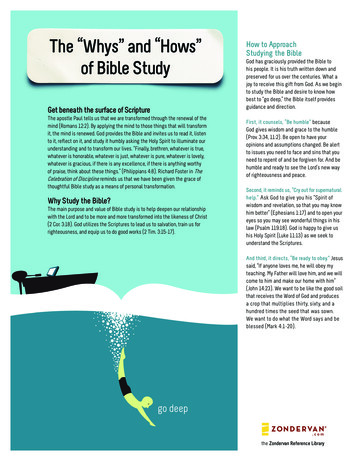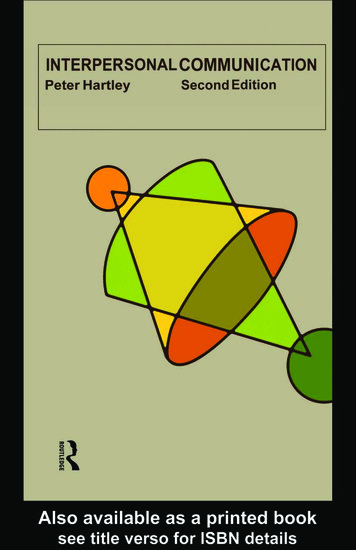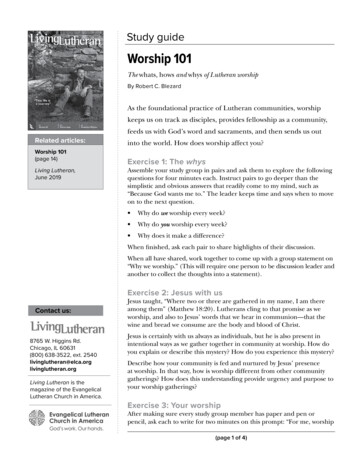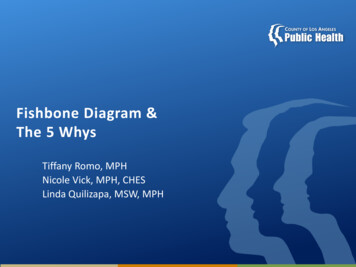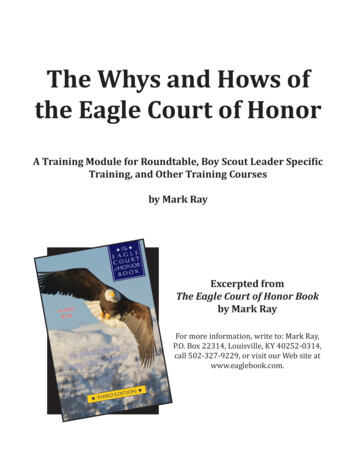
Transcription
The Whys and Hows ofthe Eagle Court of HonorA Training Module for Roundtable, Boy Scout Leader SpecificTraining, and Other Training Coursesby Mark RayExcerpted fromThe Eagle Court of Honor Bookby Mark RayFor more information, write to: Mark Ray,P.O. Box 22314, Louisville, KY 40252-0314,call 502-327-9229, or visit our Web site atwww.eaglebook.com.
The Whys and Hows of the Eagle Court of HonorA Training Module for Roundtable, Leader Specific Training, and Other Training CoursesLearning ObjectivesTechniqueAs a result of this training experience, participants should be able to: Explain the purposes of holding Eagle Scout courts of honorUnderstand the steps involved in planning courts of honorExplain the elements of an effective court of honorIdentify resources for ceremony scripts Prepared flip chart“Eagle Court of Honor Survival Kit” handout—one copy per participantDisplay materials, including The Eagle Court of Honor Book, Troop ProgramResources (formerly Woods Wisdom), sample ceremony props, sampleprinted programs, etc.MaterialsTalk, using prepared flip chart; buzz groupsReferenceThe Eagle Court of Honor BookWhy We Hold EagleCourts of Honor(8 min.)Divide the participants into buzz groups of 6 to 8 people each.Say, “The primary purpose of the Eagle court of honor is obviously to recognizeone or more Scouts for earning the Eagle Scout award. But that’s not the onlyreason we hold courts of honor.”Tell the buzz groups to take three minutes to think of other reasons for holdingEagle courts of honor. Each group should select a spokesperson to write down itsanswers and be prepared to report on them.Write “Why?” at the top of the flipchart. Below that heading, write “Recognizethe new Eagle Scout.” Then, when the time is up, have each spokesperson readhis or her group’s answers. Write the answers on the flip chart.Here are some possible answers: Presenting the new Eagle Scout with a challenge (such as to use his skills andexperience to be a leader in his troop and community)Recognizing other people (such as parents and Scout leaders) who helpedalong the Eagle trailSetting an example for other ScoutsInforming and inspiring family members, friends, Scout parents, and otherpeople in the audienceIf the groups don’t come up with these answers on their own, you may want tosuggest them.
How We Fulfill OurPurposes(3 min.)Say, “So how do we accomplish all these things in an hour-long (or shorter)ceremony?”Suggest the following “rules” of effective Eagle courts of honor: Planning the Courtof Honor(4 min.)One Eagle, one court of honor: The Eagle Scout award should generally bepresented at a special court of honor held to honor a single new Eagle—notat a regular troop court of honor or multi-Eagle affair.Fit the ceremony to the Scout: Even if you use an off-the-rack ceremony,you should tailor it to the individual. Tell about the merit badges he earned,the leadership positions he held, his camp staff experience, and his EagleScout service project.Involve the family: Consult with the family early and often, but don’t expectthem to put the whole event together. The Eagle court of honor is a troopfunction, which means a troop leader—not the honoree’s parent—should beresponsible for running it.Ask if anyone knows the answer to the old riddle, “How do you eat an elephant?”Explain that the answer—“One bite at a time”—applies to Eagle courts of honoras well.Say, “Planning a court of honor can be a daunting task. After all, you have toworry about not only writing a script but also securing a location, orderingawards and programs, requesting congratulatory letters from dignitaries, andplanning a reception.”Point out that one effective way to plan a court of honor is to use the court ofhonor backdater in the handout. Explain that a backdater is simply a step-bystep list of what you need to do and when you need to do it. Once you’ve set thecourt of honor date, you can calculate all the other dates to create a customizedbackdater for your court of honor. (Note: an online version of the backdater isavailable from the Scouting Links page at www.eaglebook.com.)Distribute the handout (if you haven’t already) and give the participants achance to review the backdater. Answer any questions they might have.The Ceremony Itself(8 min.)Say, “As we’ve seen, there’s a lot more to a good Eagle court of honor than justhanding a boy a badge.”Ask the participants to think of specific activities that should be part of the ceremony. Turn to the next flip chart page—labeled “How?”—and record their ideas.Say, “Obviously, all these things should be done in a logical order. You wouldn’t,for example, want to present the badge at the beginning of the ceremony andthen do a dozen other things before the closing.”
Turn to the next flip chart page, on which should already be listed the followingoutline:1.2.3.4.5.6.7.Before the CeremonyOpening Period (10 min.)Scouting Segment (10 min.)Eagle Scout Segment (10 min.)Presentation of the Eagle Badge (15-20 min.)Closing Period (5 min.)After the Ceremony Before the Ceremony: Displays, programs distributed, final ceremonypreparationOpening Period: Call to order and welcoming remarks, introductions,announcements, invocation, opening ceremony, formal opening of the courtof honorScouting Segment: A ceremony or presentation about the purpose andmeaning of Scouting (such as a Scout Law candle ceremony)Eagle Scout Segment: A ceremony or presentation about the significanceand history of the Eagle Scout award (such as “Trail to Eagle”)Presentation of the Eagle Badge: Honoree’s Scouting history or personalstatement, the Eagle charge, the Eagle Scout Promise, the presentation of theEagle badge, the presentation of other awards and giftsClosing Period: Closing ceremony, benediction, closing of the court of honorAfter the Ceremony: Reception, clean-upPoint out that this outline appears in the handout and then explain whathappens in each of the parts of the ceremony: Say, “The whole ceremony should build to a single emotional peak, when thehonoree is officially declared an Eagle Scout and the audience gives him astanding ovation.”101010min. min. min.ClosingPresentationof theEagle BadgeEagleSegmentScoutingSegmentTurn to the next flip chart page, on which should already be drawn the followinggraph:OpeningThe EmotionalRoller Coaster(3 min.)15-20 5min. min.Say, “Notice that the audience doesn’t stay at the peak very long. Right after thestanding ovation, they’ll start looking at their watches. That’s why everythingafter the presentation must be kept brief.”
Resources(5 min.)Say, “We can’t cover everything you need to know about Eagle courts of honor ina brief session like this. Fortunately, there are lots of resources available to helpyou.”Mention the following resources: Closing(2 min.)The Eagle Court of Honor Book: The “complete guide to Scouting’s greatestmoment”; more information is available at www.eaglebook.com.Troop Program Resources: Formerly known as Woods Wisdom, this BSApublication includes several Eagle court of honor scripts.Online resources: Numerous Web sites discuss Eagle courts of honor.Among the best are www.eaglebook.com, www.eaglescout.org,www.macscouter.com, and www.scouter.com.Local resources: Mention any local resources that you know of.Say, “The next court of honor you plan may be your first or tenth or hundreth.But it’s the only one your new Eagle Scout will ever have. The Eagle court ofhonor is a moment the boy will remember long after he becomes a man. Make itgreat.”Portions excerpted from The Eagle Court of Honor Book. Copyright 1996-2012 by Mark A. Ray.Permission is hereby granted to freely distribute and/or reproduce this document for use in Boy Scouts of Americatraining sessions provided that this notice and all other copyright notices are retained.To order a copy of The Eagle Court of Honor Book, send check or money order for 18.50 (U.S. addresses only) to:Mark Ray, P. O. Box 22314, Louisville, KY 40252-0314. Kentucky residents, please add 6% sales tax.For quantity discounts or for other inquiries, write to the above address, call 502-327-9229,send e-mail to info@eaglebook.com, or visit our Web site at www.eaglebook.com.
Call to order and welcoming remarksIntroductionsAnnouncementsInvocationOpening ceremonyFormal opening of the court of honorReceptionClean-upClosing ceremonyBenedictionClosing of the court of honorPermission is hereby granted to freely distribute this document providedthat this notice and all other copyright notices are retained.Portions excerpted from The Eagle Court of Honor Book.Copyright 1996-2012 by Mark A. Ray.7. After the Ceremony6. Closing Period(5 minutes)5. Presentation of theHonoree’s Scouting history or personalEagle Badge statement(15-20 minutes)The Eagle chargeThe Eagle Scout PromiseThe presentation of the Eagle badgeThe presentation of other awards and gifts4. Eagle Scout Segment A ceremony or presentation about(10 minutes) the significance and historyof the Eagle Scout award3. Scouting SegmentA ceremony or presentation about(10 minutes) the purpose and meaning of Scouting2. Opening Period(10 minutes)1. Before the Ceremony DisplaysPrograms distributedFinal ceremony preparationCeremony OutlineFor more information, write to: Mark Ray,P.O. Box 22314, Louisville, KY 40252-0314,call 502-327-9229, or visit our Web site atwww.eaglebook.com.Excerpted fromThe Eagle Court of Honor Bookby Mark RayAsk an adult Eagle Scout what he remembers most aboutScouting, and he’ll likely tell you about campouts in the rain,perhaps a trip to Philmont or a National Jamboree, and hisEagle court of honor. The Eagle court of honor is an eventthe boy will remember long after he becomes a man. It isScouting’s greatest moment, and this survival kit can helpyou make it just a little bit greater.The EagleronoHfotCourtiKlavivrSu
DateBoard of review is held.Chairperson is selected.Chairperson meets with family tobegin planning.Set date and time for court of honor.Secure location.Send confirmation letter to person incharge of location.Order invitations.Develop invitation list.Begin promoting the event withinthe troop.Order needed supplies from council(awards, program covers, etc.).Order plaques and otherrecognition items.Solicit congratulatory letters frompublic officials and other VIPs.Flesh out program and prepare script.Order NESA membership.Mail invitations.Recruit master of ceremonies andpresenters.Recruit volunteers to coordinatesupport functions.Distribute scripts to presenters.Order refreshments.Visit the court-of-honor location tocheck facilities.ActionAssigned ToDaysDate-2-2-1000000000 1 3 5-2-2-2-1Assigned ToHold a rehearsal with all presenters.Confirm attendance of all presenters.Confirm access to building.Set up and decorate room.Set heater or air conditioner.Check all audio-visual equipment(microphones, projectors, etc.).Make sure all awards and other propsare in place.Reserve seats for presenters, thehonoree, and his family.Set up refreshments.Position greeters at the door(s) tohand out programs.Check with all presenters one last time.THE COURT OF HONORSend thank-you notes.Send write-up (with pictures) tonewspapers.Evaluate the event and make notesfor next time.ActionHave programs printed.Mail press releases. If possible, includea black-and-white photo.Call troop families to promote.Gather all necessary materials, props,awards, etc.For more information about The Eagle Court of Honor Book, write to: Mark Ray, P.O. Box 22314, Louisville, KY 40252-0314, call 502-327-9229, or visit -4-4-3-3WeeksPhotocopy this backdater and use it as a worksheet as you begin planning the court of honor. Give copies to all participants so they know what isexpected of them. You can also complete this worksheet online at www.eaglebook.com/free backdater.htm.Eagle Court of Honor Backdater
The Eagle Court of Honor BookThe complete guide to Scouting’sgreatest moment.Since it first appeared, tens of thousands of Scouters have reliedon The Eagle Court of Honor Book to make Scouting’s greatestmoment truly great. In a straightforward style, the book answersevery question you might have about Eagle courts of honor, fromwhy you should hold a court of honor in the first place to whoshould participate to what equipment and supplies you might need.Highlights include:Eight complete ceremonies Original inspirational pieces Twenty pages of charges, poems, and quotations Nine planningchecklists Inexpensive props you can make Support jobdescriptions The history of the Eagle awardThe Scoutmaster’s Other HandbookHow to manage a troop, make adifference, and maintain your sanity.In this unique and highly personal book you’ll findhundreds of proven ideas for building strong, successful,sustainable Boy Scout troops that truly achieve the promise ofScouting. Beginning with Scouting’s aims and methods, the bookmoves quickly through every aspect of the program, from troopmeetings and outings to fundraising and administration.Highlights include:How to recruit and retain Scouts and leaders Techniquesfor nearly painless fundraising Suggested board-of-reviewquestions Tips for troop newsletters and Web sites Ideas forstrengthening patrols Dozens of print and online resourcesFor information on ordering both books, including print andelectronic editions, visit www.eaglebook.com.
One Eagle, one court of honor: The Eagle Scout award should generally be presented at a special court of honor held to honor a single new Eagle—not at a regular troop court of honor or multi-Eagle affair. Fit the ceremony to the Scout: Even if you use an off-the-rack ceremony, you should tailor it to the individual.


